II. Salient Points Concerning Foreign Nationals' Entry and Stay
1. Overall Conditions of Foreign Nationals' Entry and Stay, and Illegal Foreign Residents
(1) Foreign Nationals Entering Japan
The number of foreign nationals entering Japan was about 18,000 in 1950 when the government began to compile immigration control statistics. However, the number topped one million in 1978 and has maintained an upward trend ever since. In 2004, the number exceeded an earlier record by some one million to reach about 6.76 million (Chart 1). Owing to the government promoting measures to increase foreign tourists visiting Japan, it is expected that these measures will contribute to the number maintaining its upward trend. From a different angle, the number of cases of detection of forged or altered documents in landing and departure procedures is seeing an upward trend. It declined in 2004 from 2003 when the number had quickly increased, but the number in 2004 increased by 605 to 2,688 from 2,083 in 2000 when the 2nd Basic Plan for Immigration Control was formulated (Chart 2). Despite Japan's strict immigration control, a significant number of foreign nationals are expected to attempt to enter Japan with forged or altered documents owing to the factor of the economic gap between Japan and neighboring countries. At home and abroad, there are smuggling brokers who run businesses to smuggle stowaways into Japan and there is concern that the smuggling methods are becoming increasingly more malicious and cunning.
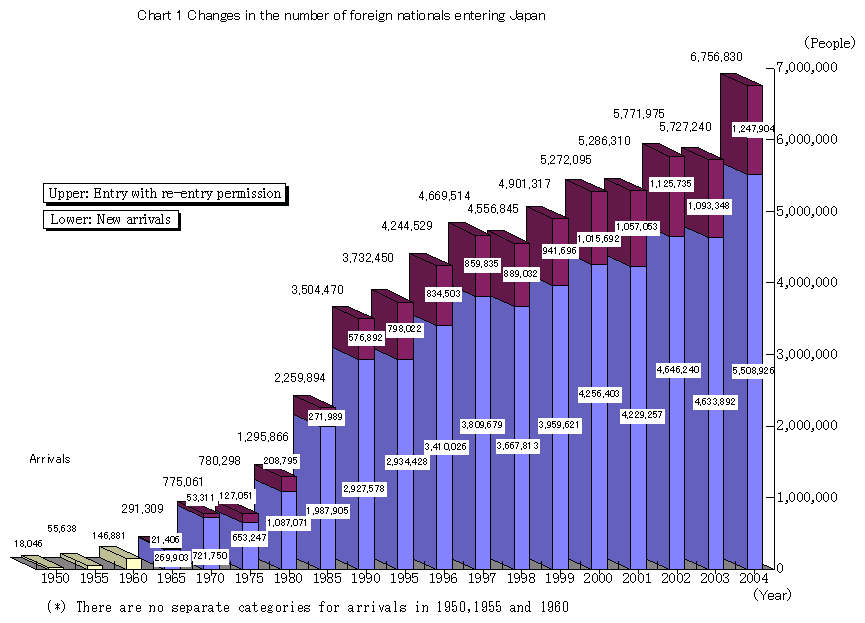
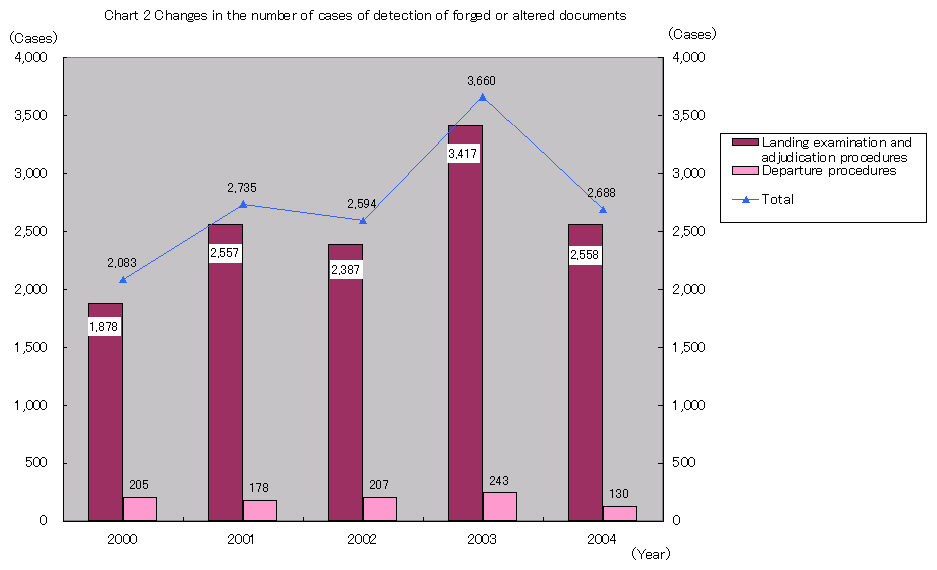
(2) Foreign Nationals Residing in Japan
Between the end of the war and 1965, the number of registered foreign nationals residing in Japan remained between 550,000 and 650,000. Special permanent residents, mainly comprised of Korean nationals accounted for nearly 90% of the total. Since the late 1960s, the number of special permanent residents has decreased, while the number of foreign nationals coming to stay in Japan for various purposes has increased. An increasing number of foreign nationals have been living in Japan for a medium-length or long time. Therefore, the number of foreign nationals residing in Japan has risen year by year. At the end of 2003, the number of registered foreign nationals residing in Japan hit a record 1.92 million. Their share of Japan's total population also posted an all-time high of 1.5% (Chart 3). Special permanent residents made up 24.9% of the registered foreign residents at most, while the share increased for newcomer foreign nationals. This trend is expected to continue with the number of foreign residents in Japan increasing.
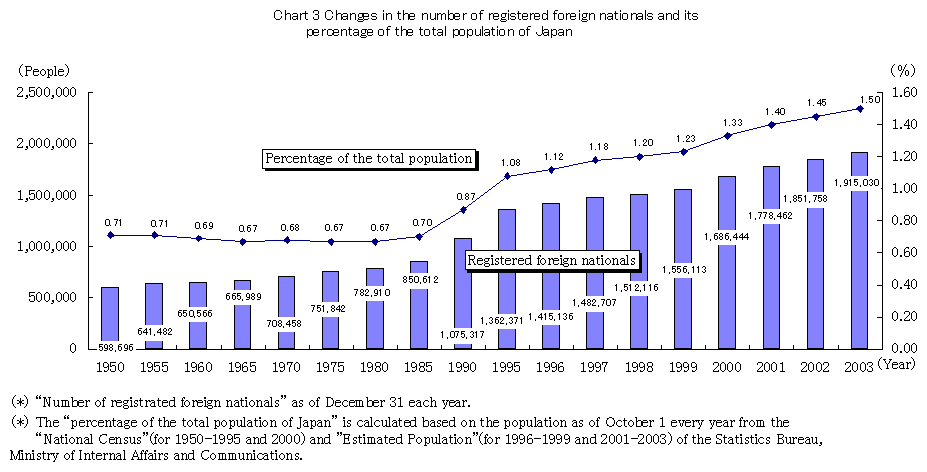
(3) Illegal Foreign Residents
The number of overstayers (those who illegally stay in Japan beyond the permitted periods of stay without obtaining permission for extension or change of status of residence), as estimated through the computer statistics of the Immigration Control Bureau, peaked at about 300,000 as of May 1, 1993, and declined to around 210,000 as of January 1, 2005 (Chart 4). In addition, an estimated 30,000 foreign nationals are considered to have illegally entered Japan, smuggled in on boats or other vessels, and to be lying low. The total number of illegal foreign residents is thus estimated at some 240,000.
The number of overstayers is decreasing year by year because of various measures against illegal foreign residents in Japan such as intensified detection, and also owing to the prolonged economic slump. On January 1, 2005, the number declined by more than 10,000 from a year earlier. The decline, however, has slowed down over recent years. This indicates that a large number of foreign nationals are still attempting to enter Japan for illegal employment against the background of economic gaps between Japan and neighboring countries. It also indicates that illegal foreign residents have been willing to stay in Japan longer rather than returning to their home countries. Among the employers of illegal foreign residents, some businesses take advantage of the illegal foreign residents as cheap labor amid severe economic competition. There are also some brokers who attempt to illegally earn massive incomes by helping illegal foreign residents obtain jobs. The number of illegal foreign residents working or living in one location has decreased and illegal foreign residents have dispersed more widely. This trend has made it difficult for authorities to detect illegal foreign residents.
The number of foreign nationals who violated the Immigration Control Act and underwent deportation procedures in 2004 totaled 55,351. Over recent years, a rising number of foreign nationals authorized to stay and work in Japan have been ordered to undergo deportation due to their taking part in unauthorized work activities.
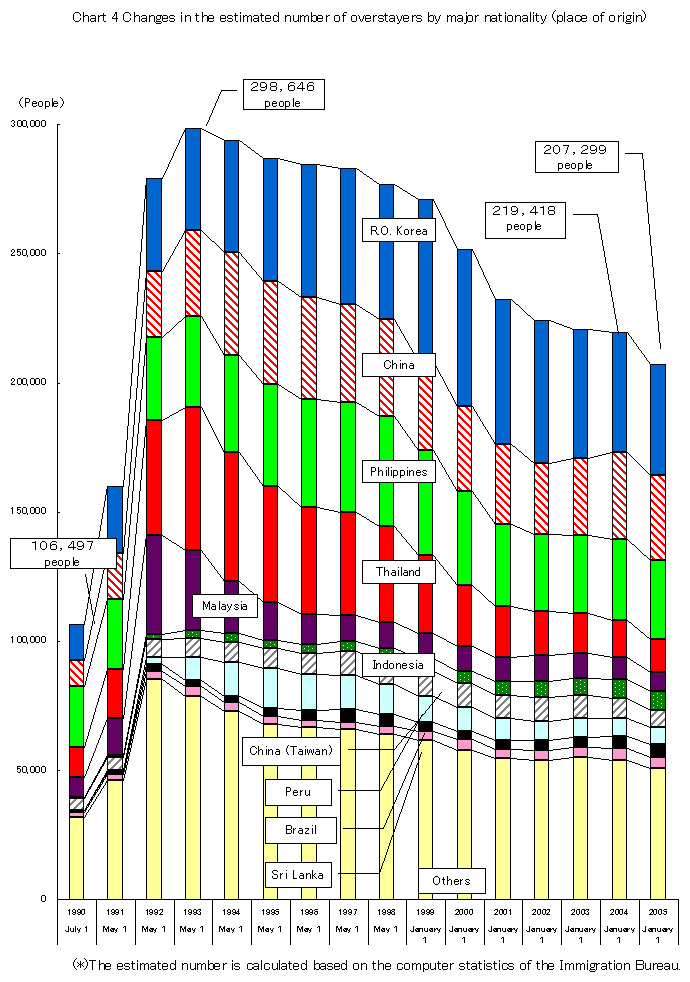
2. State of Foreign Nationals by Status of Residence
(1) Foreign Nationals Staying in Japan for the Purpose of Employment
The number of foreign nationals newly entering Japan with a status of residence for the purpose of employment (excluding the statuses of residence of “Diplomat” and “Official”) totaled 158,877 in 2004. The number of registered foreign residents with the same status came to 185,556 at the end of 2003. Both numbers have consistently increased over recent years (Charts 5 and 6).
The annual number of foreign corporate employees newly entering Japan with the status of residence of “Engineer,” “Specialist in Humanities/International Services” and “Intra-company Transferee” has fluctuated over recent years. On the other hand, the number of registered foreign residents with the same statuses has increased almost consistently. It is considered to be an indication that foreign nationals residing in Japan with those statuses tend to stay longer or settle down in Japan. In addition, a considerable number of foreign nationals with the status of residence of “College Student” have been permitted to change their status to those three statuses.
The number of foreign nationals newly entering Japan with the status of residence of “Entertainer” totaled 134,879 in 2004. The number of registered foreign nationals with that status in Japan came to 64,642 at the end of 2003. Both numbers are increasing. The number of foreign nationals newly entering Japan with the status of residence of “Entertainer” in 2004 by nationality (place of origin) shows that the Philippines accounted for 82,741 or 61.3% of the total, followed by China, which was 8,277, and the United States, which was 6,074. The number of registered foreign nationals with the same status at the end of 2003 by nationality (place of origin) indicates that the Philippines accounted for 50,539 or 78.2% of the total, followed by China, which was 3,848, and Romania, which was 2,597. On the other hand, the number of overstayers who formerly had the status of residence of “Entertainer” came to 11,319 as of January 1, 2005 with the Philippines accounting for 87.2% of that number.
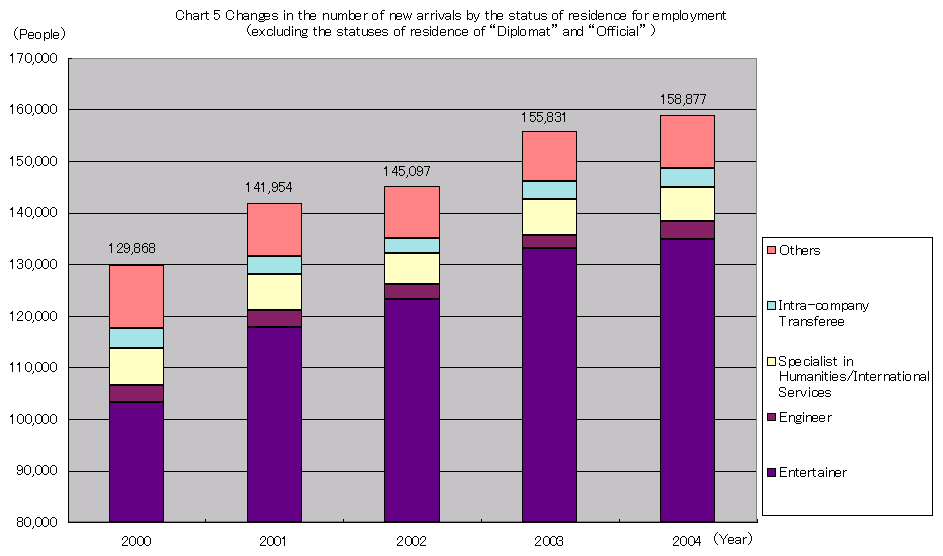
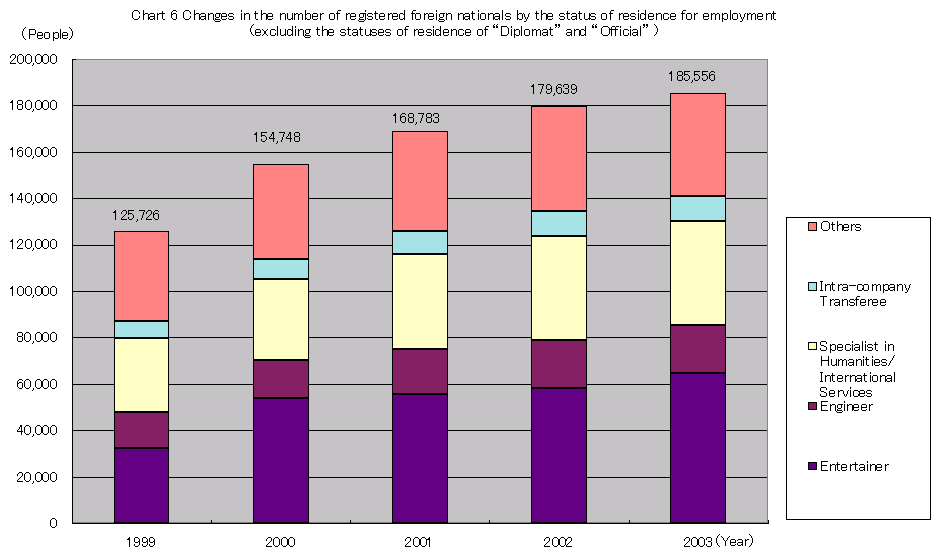
(2) Foreign Nationals Staying in Japan for the Purpose of Study
The number of foreign nationals newly entering Japan with the statuses of residence of “College Student” and “Pre-college Student” continued to increase before their downturn in 2004. 21,958 foreign nationals entered Japan with the “College Student” status and 15,027 foreign nationals with the “Pre-college Student” status in 2004. By nationality (place of origin), China accounted for the largest shares - 8,133 people (37.0%) for the “College Student” status and 5,705 people (38.0%) for the “Pre-college Student” status in 2004. At the end of 2003, the number of registered foreign residents with the “College Student” status came to a record high of 125,597. The number of those with the “Pre-college Student” status also hit a new high of 50,473. By nationality (place of origin), China accounted for the largest shares - 87,091 people (69.3%) for the “College Student” status and 38,873 people (77.0%) for the “Pre-college Student” status (Charts 7 and 8).
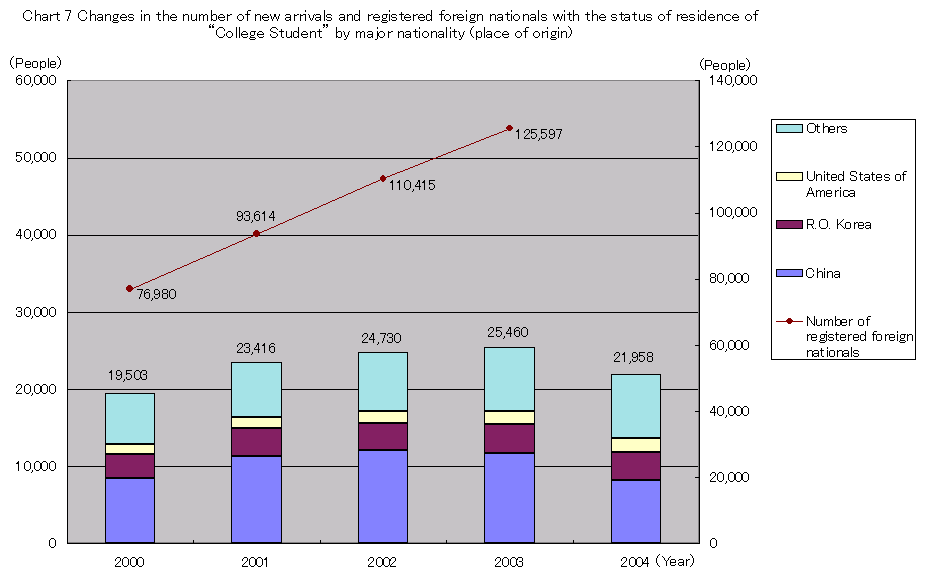
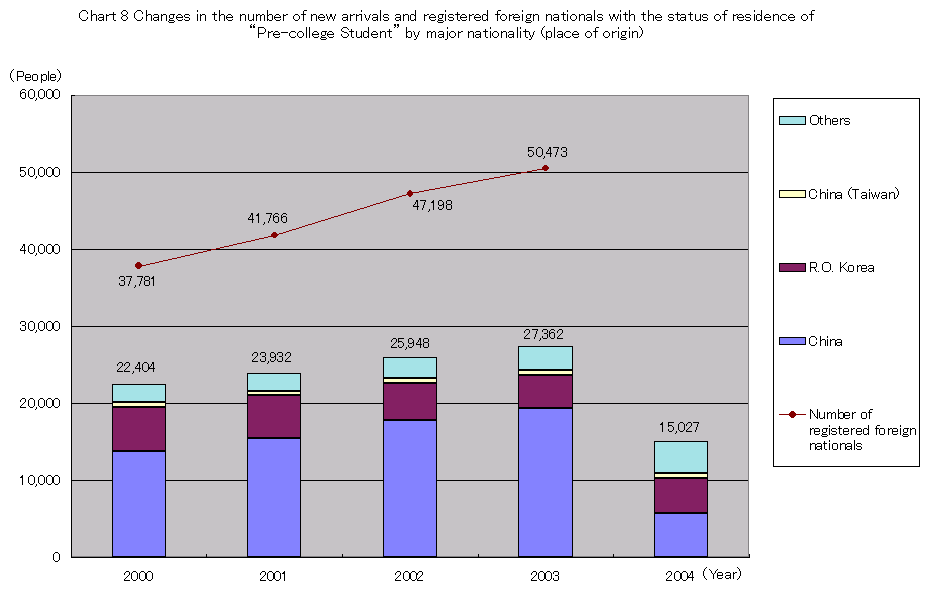
On the other hand, foreign students whose real purpose to stay in Japan is to work or who begin to work due to financial difficulties are on the increase. The number of overstayers who had had the status of residence of “College Student” has begun to increase over recent years, reaching 8,173 as of January 1, 2005. China accounted for 86.1% of that number. The number of those as “Pre-college Student” has been declining over recent years. As of January 1, 2005, however, the number of those with the status of residence of “Pre-college Student” was 8,506, of which China accounted for 83.7%.
The number of foreign nationals newly entering Japan and the number of registered foreign residents with the status of residence of “Trainee” have consistently increased over the past years. In 2004, a record high of 75,359 foreign nationals entered Japan with the “Trainee” status. At the end of 2003, the number of registered foreign residents with the status came to a new high of 44,464 (Chart 9). The number of trainees taking part in technical internship programs after finishing their training has risen year by year, reaching 26,488 in 2004 (Chart 10). The number of foreign trainees entering Japan in 2004 by nationality (place of origin) showed that China accounted for 48,729 or 64.7% of the total, followed by Indonesia, which was 5,204 and Vietnam, which was 3,835. Of the registered foreign residents with the “Trainee” status at the end of 2003, China accounted for 30,763 or 69.2%, followed by Indonesia which was 4,234, and Vietnam, which was 3,528. As Asian economies are expected to develop further, the number of foreign trainees and technical interns in Japan is predicted to increase. On the other hand, the number of overstayers who had had the status of residence of “Trainee” stood at 3,648 as of January 1, 2005. The number is an upward trend, indicating that a growing number of foreign trainees are staying in Japan even after their authorized training periods.
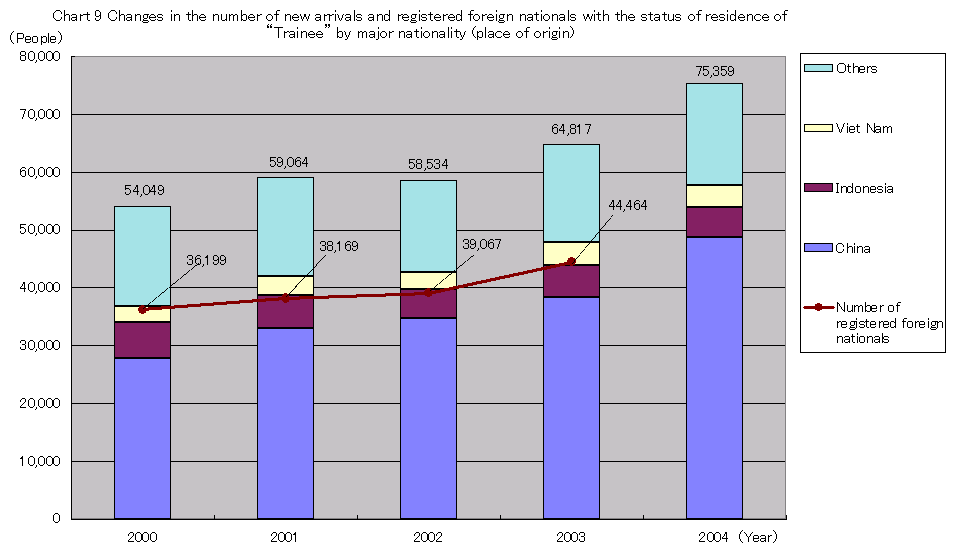
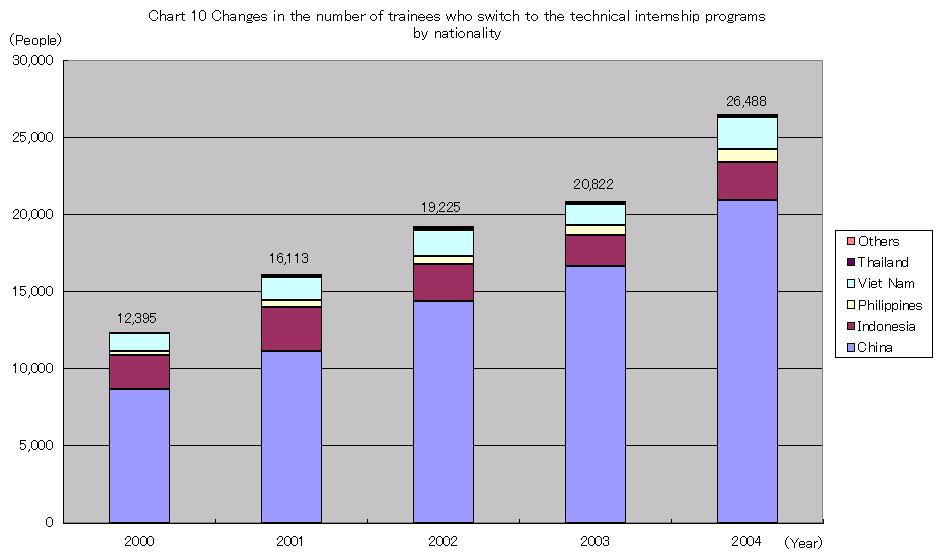
(3) Foreign Nationals Entering and Staying in Japan with the Statuses of Residence for Resident Activities Based on Civil Status or Position
The number of foreign nationals newly entering Japan with the status of residence of “Spouse or Child of Japanese National” was 23,083 in 2004. At the end of 2003, 271,719 registered foreign residents had this status. Both numbers have repeatedly fluctuated over recent years. Foreign nationals entering and staying in Japan with this status include children of Japanese nationals as well as the spouses of Japanese nationals. A steady annual number of Japanese nationals marrying foreign nationals has contributed to the increase in the registered foreign residents with the status. Second-generation children of Japanese nationals who emigrated to South American countries are ageing, serving to reduce the number of foreign nationals entering Japan with this status. Some foreign residents with the status have chosen to change to the “Permanent Resident” status or to be naturalized in Japan. This has become a factor working to reduce the number of registered foreign residents with the “Spouse or Child of Japanese National” status.
Since there are no restrictions on work for foreign nationals with the “Spouse or Child of Japanese National” status, some foreign nationals have taken advantage of sham marriages to enter or stay in Japan.
The number of foreign nationals newly entering Japan with the status of residence of “Long-Term Resident” has repeated fluctuations over recent years. The number of registered foreign residents with the status has been on the rise, standing at 245,147 at the end of 2003. Japanese descendants staying in Japan with the “Long-Term Resident” or “Spouse or Child of Japanese National” status contribute to the globalization and diversification of Japanese society. Some of them, however, reportedly remain in unstable working environments and fail to make social insurance payments or to have their children go to school.
(4) Permanent Residents
The number of registered foreign residents with the status of residence of “Permanent Resident” stood at 267,011 at the end of 2003, up some 20% from a year earlier. The number has increased greatly along with the number of foreign nationals residing in Japan for a longer period. The rising number of foreign nationals hoping to change to the “Permanent Resident” status is expected to continue an upward trend.
